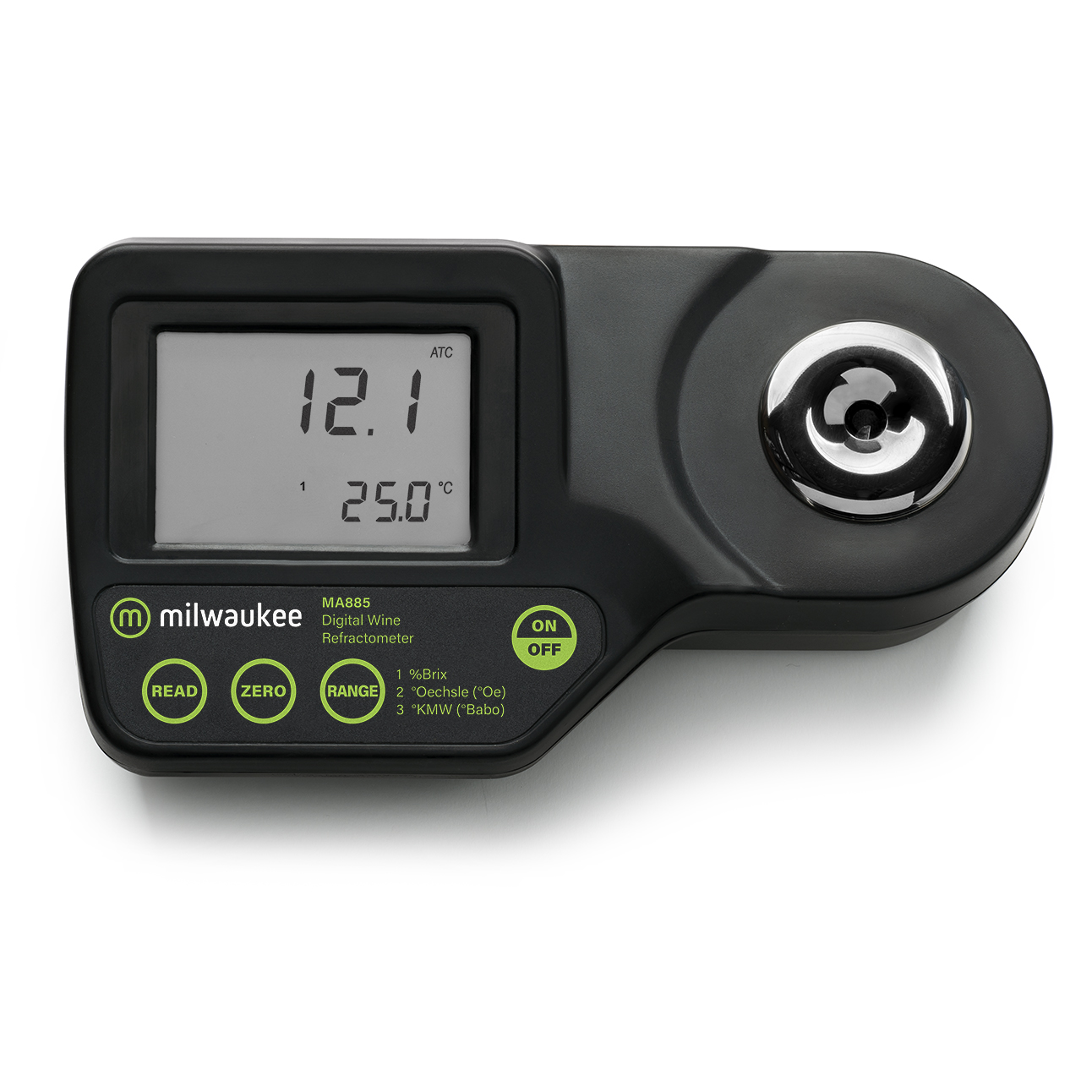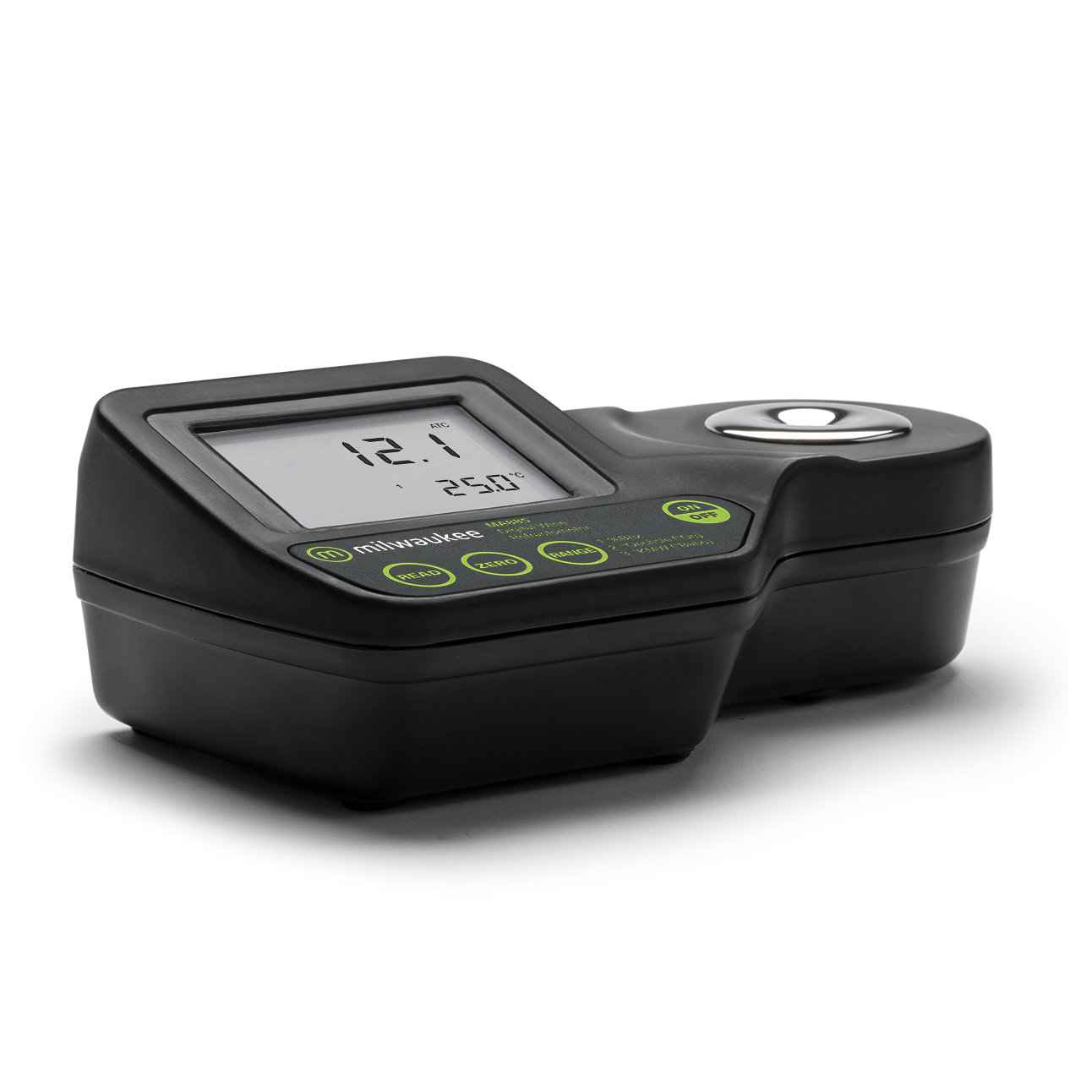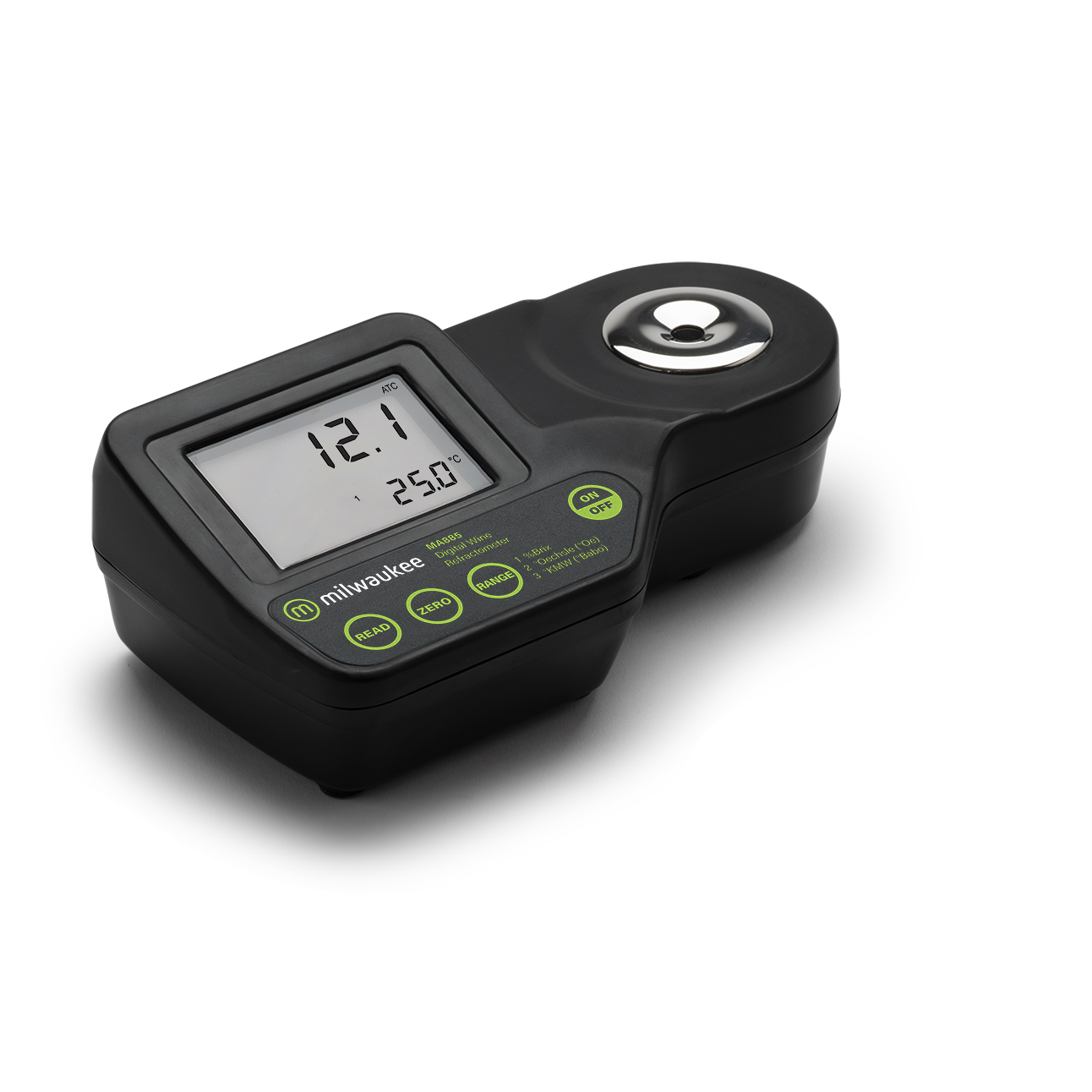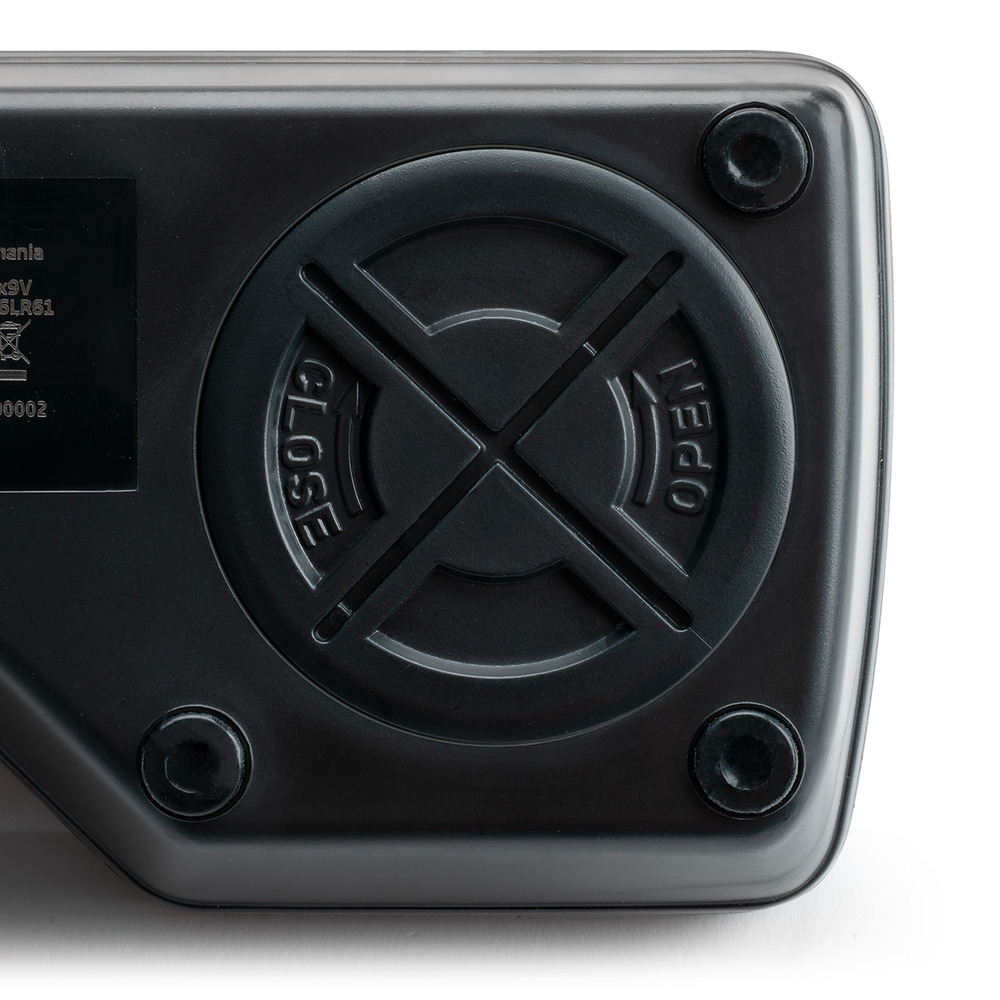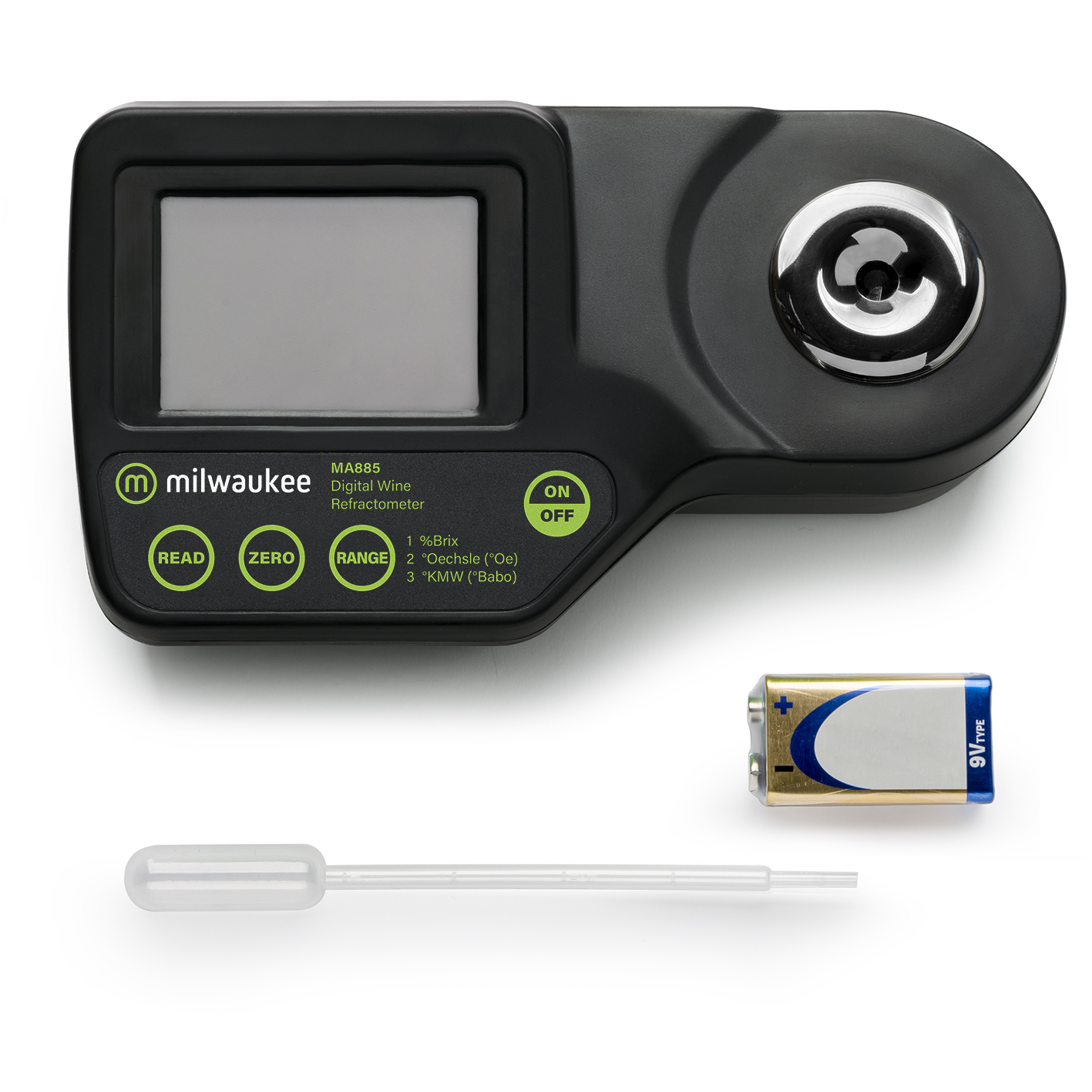Your shopping cart is currently empty.
Milwaukee MA885 Digital Refractometer – Brix, °Oechsle, and °KMW Analysis for Winemaking & Brewing
The Milwaukee MA885 Digital Refractometer is designed for winemakers, brewers, syrup producers, and food industry professionals who require fast, accurate sugar content analysis. This temperature-compensated digital meter eliminates the inaccuracies of traditional optical refractometers by providing precise Brix, °Oechsle, and °KMW readings in seconds. With a sealed flint glass prism and a stainless steel sample well, the MA885 is built for both laboratory and field use. Whether you're crafting wine, brewing beer, or producing syrup, this refractometer ensures reliable, consistent results.
The MA885 is also ideal for various industries, offering versatile applications across the board. In agriculture, it's perfect for measuring sugar content in fruits and vegetables, ensuring quality control throughout the farming process. For enology, it's an essential tool for winemakers, allowing them to monitor the sugar concentration in grapes, must, and wine, ensuring optimal fermentation and final product quality. In the food and beverage industry, it's crucial for testing sweetness levels in beverages and food products, helping maintain consistency and quality. Brewers in the beer industry also rely on the MA885 to check sugar levels in beer wort, which is key for fermentation control and product consistency. In horticulture, the refractometer is used by growers to monitor sugar content in fruits and vegetables, optimizing cultivation techniques and enhancing product quality.
Beyond food and agriculture, the MA885 is valuable in pharmaceuticals to ensure consistent sugar concentrations in medicinal syrups and solutions, supporting high-quality production. In juice production, it helps monitor the sugar content in fruit juices, ensuring the desired sweetness and flavor consistency. For honey production, the MA885 is vital for ensuring the sugar content of honey meets industry standards. Finally, in aquaculture, it is used to measure sugar content in fish feed, optimizing the formulation for fish health and growth.
With the Milwaukee MA885, you get precise, reliable, and quick measurements across various industries, making it a versatile tool for professionals demanding accuracy in sugar content analysis.
Why Choose the Milwaukee MA885?
· Accurate & Reliable – Measures 0 to 50% Brix, 0 to 230° Oechsle, and 0 to 42° KMW, with a precision of ±0.2% Brix / ±1°Oe / ±0.2° KMW.
· Fast Readings – Get results in under 2 seconds with just 2-3 drops of sample.
· Easy Calibration – One-point calibration with distilled or deionized water for hassle-free maintenance.
· Digital Precision – Avoid human error with a clear, dual-level LCD display for quick interpretation.
· Efficient Battery Use – Long battery life, with a percent-level indicator and automatic shut-off.
· Easy-to-Clean Sample Well – Stainless steel anti-corrosion well for long-term performance.
· ICUMSA-Compliant – Uses internationally recognized sugar measurement methods for reliable results.
Maintenance Tips for the MA885 Digital Refractometer:
To ensure the longevity and accuracy of your Milwaukee MA885 Digital Refractometer, proper maintenance is essential. Follow these tips to keep your refractometer in top condition:
- Clean the Prism After Each Use:
- Always clean the prism and sample well with a soft, lint-free cloth after each measurement.
- For stubborn residues, use a mild detergent diluted with water, ensuring all cleaning solutions are thoroughly wiped away to avoid contamination in future readings.
- Avoid using abrasive materials that can scratch the prism surface.
- Calibrate Regularly:
- Calibrate the refractometer with distilled water (which should read 0.0% Brix) before every use or if the unit shows signs of inaccuracies. Calibration ensures the readings remain precise.
- Ensure calibration is done in a clean environment to avoid contamination of the reference solution.
- Store Properly:
- Store the refractometer in a clean, dry place when not in use. Avoid exposure to direct sunlight, high temperatures, or humidity.
- Use the protective case provided with the refractometer to prevent damage from dust, dirt, or physical impact.
- Avoid storing the device in environments where it may be exposed to corrosive substances, as this can damage internal components.
- Check the Battery:
- Regularly check the battery level and replace it when necessary. This ensures the refractometer is always ready for use.
- When replacing the battery, use the recommended type specified in the user manual to avoid damaging the device.
- Avoid Submerging in Water:
- The MA885 is designed to withstand occasional exposure to water, but do not fully submerge the unit in liquid. This could damage the internal components.
- Handle With Care:
- Always handle the refractometer with clean hands to avoid contamination of the sample and to maintain the integrity of the prism.
- Avoid dropping or mishandling the device, as this can cause internal damage and affect performance.
By following these simple maintenance tips, you can ensure that your Milwaukee MA885 Digital Refractometer continues to provide accurate, reliable readings for years to come, maintaining its performance and longevity.
Upgrade to the Milwaukee MA885 – Precision You Can Trust
The Milwaukee MA885 Digital Refractometer helps winemakers, brewers, and food producers achieve professional-grade accuracy with fast, reliable results.
Take the guesswork out of sugar content measurement—upgrade to digital precision today!
Specifications
Application
Enology & Winemaking
In enology and winemaking, the MA885 Digital Refractometer plays a crucial role in monitoring the sugar content of grapes, must (the crushed grape juice, skins, seeds, and stems), and wine during the fermentation process. The sugar content, typically measured in Brix, directly influences the fermentation process and the final alcohol content in the wine.
Before fermentation begins, winemakers use the MA885 to measure the sugar concentration in grapes to assess their ripeness. This helps them decide the optimal harvest time, ensuring the grapes have reached the desired level of sugar for the style of wine they want to produce. The refractometer provides a precise Brix reading, allowing winemakers to track the sugar levels in different batches of grapes and select the best grapes for winemaking.
Once the grapes are crushed and the must is prepared, the MA885 is used to measure the sugar content in the must. This is essential for determining how much sugar is available for fermentation and predicting the potential alcohol content in the finished wine. The refractometer’s accuracy ensures that winemakers can monitor this critical stage and make adjustments if needed, such as adding more sugar or diluting the must.
During fermentation, the MA885 is also used to track the sugar depletion, as yeast consumes the sugar to produce alcohol. By regularly measuring the Brix, winemakers can determine when the fermentation process is nearing completion and make timely decisions about stopping fermentation, such as through cooling or filtering, if necessary.
In addition to Brix, the MA885 provides readings in °Oechsle and °KMW, which are specific to enology. These units help wine professionals in different regions measure and assess the quality and potential alcohol content of the wine. The °Oechsle scale is commonly used in Germany and Switzerland, while the °KMW scale is popular in France.
In short, the MA885 refractometer provides precise and fast sugar content measurements throughout the winemaking process, helping winemakers ensure consistent quality and control over the fermentation process and the final product.
How to use?
- Preparation
- Before using the MA885, ensure that the refractometer is clean and calibrated. Calibrate it using distilled water (reading should be 0.0% Brix).
- Make sure the prism is clean and free of residue before each use.
- Measuring Grape Sugar Content (Pre-Harvest)
- Harvest a small sample of ripe grapes.
- Cut a few grapes in half to release the juice.
- Place a few drops of grape juice directly onto the refractometer's prism. Avoid placing solid material or skins on the prism.
- Close the cover to spread the juice evenly across the prism.
- Look through the eyepiece or check the digital display (depending on the model) to read the Brix value, which indicates the sugar content of the grapes. This reading helps determine if the grapes have reached the desired level of ripeness for harvesting.
- Measuring Must Sugar Content (Post-Crushing)
- After crushing the grapes, collect a small sample of the must (the mixture of juice, skins, and seeds).
- Place a few drops of the must onto the refractometer’s prism, ensuring it covers the surface evenly.
- Close the cover and read the Brix value on the digital display. This measurement indicates the sugar concentration in the must and helps determine the potential alcohol content of the wine.
- Use the Brix reading to decide if adjustments (such as adding sugar or water) are needed for optimal fermentation.
- Monitoring Fermentation Progress
- During fermentation, take periodic measurements of the must to monitor how much sugar is being consumed by the yeast.
- Use a sample of the fermenting wine (must) to check the sugar content. Place a few drops of the wine on the prism and close the cover.
- As fermentation progresses, the Brix value will decrease, indicating the consumption of sugar. Track this reduction to determine the fermentation progress.
- You may also use the °Oechsle or °KMW scales, depending on your region, for more precise fermentation monitoring.
- Post-Fermentation and Wine Quality
- After fermentation is complete, use the refractometer to measure the final sugar content in the wine, ensuring that it has reached the desired alcohol level and taste profile.
- If further adjustments are needed (such as fortification or dilution), the refractometer can help guide these decisions by providing accurate sugar content readings.
Tips for Best Results:
- Always clean the prism between measurements to avoid contamination of samples.
- Use a sufficient amount of juice or must to ensure an accurate reading.
- The MA885 is temperature-compensated, but if using it in extreme temperatures, give the refractometer time to adjust to room temperature before taking measurements.
- For consistency, use the same sample type (grape juice, must, or wine) throughout the analysis to avoid discrepancies in readings.
By following these steps, the MA885 refractometer will help winemakers ensure precision and control over the entire winemaking process, from grape selection to fermentation and final wine quality.
Brewing
In brewing, the Milwaukee MA885 Digital Refractometer is an essential tool for measuring the sugar content in beer wort, helping brewers maintain control over the fermentation process and achieve the desired alcohol content. By providing fast, accurate readings of the sugar concentration (measured in Brix), the MA885 ensures brewers can make informed decisions throughout the brewing process.
Before fermentation, the MA885 helps brewers assess the sugar content in the wort, the liquid extracted from malted barley. This early measurement indicates the potential alcohol content of the finished beer and allows brewers to determine if any adjustments to the wort (such as adding extra sugars or water) are needed to achieve the desired flavor profile.
During fermentation, the MA885 enables brewers to track how much sugar is being consumed by the yeast. As fermentation progresses, yeast consumes the sugar in the wort to produce alcohol. By periodically measuring the Brix, brewers can monitor fermentation and know when it’s nearing completion. This data is crucial in ensuring the fermentation process is controlled and completed to perfection.
The MA885 is not only accurate but also highly reliable, providing readings in seconds with its temperature-compensated technology, which compensates for temperature fluctuations to give precise readings every time. Whether you're crafting lagers, ales, or any other style of beer, the MA885 is an invaluable tool for consistent and high-quality beer production.
How to Use the Milwaukee MA885 Digital Refractometer in Brewing
- Preparation
- Before using the MA885, ensure the refractometer is clean and calibrated. Calibrate it with distilled water (reading should be 0.0% Brix).
- Ensure the prism is free from residue or contamination before each use.
- Measuring Wort Sugar Content (Pre-Fermentation)
- After brewing the beer wort (the liquid extracted from malted barley), take a small sample of the wort.
- Place a few drops of the wort onto the refractometer's prism. Ensure that the sample covers the entire surface of the prism.
- Close the cover to spread the sample evenly.
- Look through the eyepiece or check the digital display (depending on the model) to read the Brix value. This measurement indicates the sugar concentration in the wort and gives an estimate of the potential alcohol content of the final beer.
- This reading helps you monitor the efficiency of your mash and whether adjustments need to be made to the wort before fermentation begins.
- Measuring Post-Fermentation Sugar Content
- After fermentation begins, it’s important to regularly check the sugar content of the wort to track how much the yeast is consuming.
- Take a small sample of the fermenting beer and place a few drops onto the refractometer’s prism.
- Close the cover and read the Brix value to determine how much sugar has been consumed by the yeast. As the fermentation process continues, the Brix value should decrease.
- By measuring the sugar content over time, brewers can predict when the fermentation will be complete and ensure the yeast has consumed all available fermentable sugars.
- Tracking Fermentation Progress
- During fermentation, take periodic measurements of the beer wort or fermented beer to monitor the decrease in sugar levels.
- Use the refractometer to sample the beer at regular intervals (typically every 2–3 days) to track how much sugar remains. As fermentation nears completion, the Brix reading will stabilize at a lower level.
- You can also use the °Oechsle or °KMW scales if you need more region-specific measurements for the brewing process.
- Post-Fermentation and Quality Control
- After fermentation has finished, measure the final sugar content to ensure the beer has fermented to the desired alcohol level and flavor profile.
- If adjustments are necessary (e.g., to increase alcohol content or sweetness), the refractometer helps guide these decisions by providing precise sugar readings.
- The final Brix value should be low, indicating that most of the fermentable sugars have been converted to alcohol. This ensures that the beer has fermented properly and is ready for conditioning or bottling.
Tips for Best Results:
- Clean the prism thoroughly after each measurement to avoid contaminating the next sample.
- Ensure a sufficient sample size to get an accurate reading—just a drop or two is usually enough.
- The MA885 is temperature-compensated, but if you’re using it in extreme conditions, allow the refractometer to stabilize to room temperature before taking measurements.
- Consistent sampling is key—make sure you're using wort or beer from the same batch throughout your measurements to avoid discrepancies.
By following these steps, the MA885 Digital Refractometer will help you maintain precision and consistency in your brewing process, allowing you to monitor the sugar levels and fermentation progress to ensure high-quality beer production.
Food & Beverage Industry
The Milwaukee MA885 Digital Refractometer is widely used in the Food & Beverage industry for measuring the sugar content in various liquids and semi-solids, ensuring product quality, consistency, and compliance with industry standards. The refractometer provides accurate and fast measurements of sugar content, helping manufacturers maintain control over their production processes, optimize recipes, and meet specific product specifications.
In the Food & Beverage sector, the MA885 is primarily used for measuring Brix, which indicates the percentage of sucrose in a liquid, and is a standard measure for sugar content. The refractometer is crucial in the production of products such as:
- Juices: For quality control, the MA885 is used to measure the Brix level in fruit juices and concentrates, ensuring that they meet the required sweetness levels and consistency. Consistent sugar content is important for flavor and nutritional standards.
- Syrups: In syrup production, the MA885 helps manufacturers monitor sugar concentration to ensure the syrup has the correct viscosity and sweetness. It is commonly used for maple syrup, honey, and corn syrup.
- Beverages: For soft drinks, energy drinks, and flavored waters, maintaining the correct sugar concentration is key to achieving the desired taste profile. The MA885 allows beverage producers to monitor the sugar levels and adjust formulations as needed.
- Confectionery: In the production of candies, chocolates, and other sweet products, sugar concentration plays a vital role in the texture, taste, and overall quality. The MA885 is used to ensure consistency and quality in these products.
- Wines and Spirits: In the production of wine, beer, and spirits, sugar content is closely monitored during fermentation to predict alcohol content and adjust recipes as necessary. The MA885 helps measure the sugar concentration of the raw materials before fermentation, as well as during the fermentation process.
- Dairy: For dairy products like flavored milk, yogurt, and ice cream, maintaining an optimal sugar level ensures that the product tastes as expected and remains consistent in texture and quality. The MA885 helps in the control of sugar content, which directly influences flavor and mouthfeel.
Benefits of the MA885 in the Food & Beverage Industry:
- Accuracy and Speed: The MA885 provides quick and precise readings, allowing food and beverage producers to make on-the-spot decisions regarding sugar concentration, avoiding delays and ensuring consistent product quality.
- Temperature Compensation: With its automatic temperature compensation, the MA885 ensures that readings are accurate even in varying ambient temperatures, which is particularly important in industrial environments where temperature can fluctuate.
- Quality Control: By enabling frequent, precise measurements, the MA885 helps maintain product consistency and ensures that the finished product adheres to the required specifications for sweetness, flavor, and texture.
- Compliance: The refractometer helps ensure that products meet industry standards for sugar content and other relevant quality controls, facilitating regulatory compliance and reducing the risk of batch failures.
In summary, the Milwaukee MA885 Digital Refractometer is an invaluable tool for the Food & Beverage industry, helping manufacturers control sugar content, ensure consistent product quality, and optimize production processes for a wide variety of products.
How to use?
- Preparation
- Before using the MA885, ensure the refractometer is clean and properly calibrated. Calibrate it with distilled water (the reading should be 0.0% Brix).
- Clean the prism thoroughly between measurements to avoid cross-contamination between samples.
- Ensure the refractometer is in good working condition and that the sample well is free from debris or residue.
- Measuring Sugar Content in Juices, Syrups, and Beverages
- Juices & Concentrates: Take a small sample of the juice or concentrate and place a few drops onto the refractometer's prism.
- Syrups: For syrup, place a few drops of the liquid directly onto the prism. Make sure the sample evenly covers the surface of the prism.
- Beverages: For soft drinks, energy drinks, or flavored waters, take a small sample from the production batch and place it onto the prism.
- Close the cover to ensure the sample is spread evenly across the prism surface.
- Look through the eyepiece or check the digital display (depending on the model) to read the Brix value, which indicates the sugar content.
- Use the Brix reading to verify the sweetness level and consistency of the product. If necessary, adjust the formulation (e.g., add more sugar or water) to achieve the desired sugar concentration.
- Measuring Sugar Content in Confectionery
- Candies & Chocolates: Place a small sample of the candy syrup or melted chocolate onto the refractometer’s prism.
- Ensure that the sample covers the prism surface evenly and close the cover.
- Check the Brix value to assess the sugar concentration. This measurement is critical for maintaining the proper texture, taste, and mouthfeel of confectionery products.
- Adjust sugar content as needed to meet product specifications.
- Measuring Sugar Content in Dairy Products
- Milk & Yogurt: Place a few drops of the milk or yogurt mixture onto the refractometer prism.
- Ensure the sample covers the prism’s surface and close the cover.
- The Brix value will provide an accurate measure of the sugar content in the dairy product, helping ensure that the sweetness level is consistent with consumer expectations.
- If adjustments are needed, add sugar or modify the recipe accordingly to meet taste and quality requirements.
- Measuring Sugar Content in Wine, Beer, and Spirits
- Pre-Fermentation (Wine & Beer): Take a sample of the wort (beer) or must (wine) before fermentation begins and place it onto the refractometer’s prism.
- Close the cover and read the Brix value. This will help you assess the potential alcohol content and ensure the correct sugar levels for fermentation.
- During fermentation, periodically measure the sugar content to track the sugar depletion as yeast consumes the sugar and converts it to alcohol.
- Use the refractometer to monitor the fermentation progress and make adjustments if necessary.
- Post-Measurement and Quality Control
- After taking measurements, always clean the prism thoroughly to ensure no residue remains from the sample. This is especially important when measuring multiple different products to avoid contamination.
- Check the Brix value regularly to ensure that the sugar content stays within the desired range throughout production.
- Adjustment of Sugar Content (If Necessary)
- If the Brix value is too high or too low compared to the desired range, you can adjust the product's sugar content by either adding more sugar or diluting the sample with water, depending on the desired outcome.
Tips for Best Results:
- Always use fresh samples and avoid any contamination between batches.
- Ensure that the sample size is adequate to fully cover the prism surface (usually just a drop or two is sufficient).
- The MA885 is temperature-compensated, but if you are working in very high or low temperatures, allow the refractometer to adjust to room temperature before taking readings.
- Consistent calibration is important for accuracy. Ensure the refractometer is calibrated regularly with distilled water.
By following these steps, the MA885 Digital Refractometer helps ensure that sugar levels in various food and beverage products are consistently measured, making it an invaluable tool in maintaining product quality, flavor, and consistency across batches.
Agriculture
In agriculture, measuring the sugar content in fruits and vegetables is crucial for quality control and ensuring that the crops meet industry standards for taste, ripeness, and overall quality. The sugar content of a fruit or vegetable, often measured in Brix, plays a significant role in determining the final flavor profile, texture, and overall consumer appeal.
Importance of Sugar Measurement in Agriculture
- Quality Control: Sugar content is a key indicator of fruit and vegetable ripeness. High sugar levels typically indicate that the produce is at its peak flavor, sweetness, and ripeness. By measuring sugar content at different stages of growth or harvest, farmers and producers can ensure that the produce meets quality standards before being sold or processed.
- Flavor Profile: The sugar content in fruits and vegetables, especially in crops like apples, grapes, tomatoes, and peppers, directly affects their flavor. For example, in grapes used for winemaking, the sugar level (measured in Brix) helps determine the potential alcohol content of the wine. In tomatoes, the sweetness and overall flavor can vary depending on sugar levels, affecting taste and marketability.
- Harvest Timing: Measuring sugar content helps farmers determine the optimal time for harvesting. If fruits or vegetables are harvested too early, the sugar content may be too low, resulting in underdeveloped flavors and a less desirable product. Conversely, if they are harvested too late, sugar levels may become excessively high, leading to overly sweet produce that may not meet market preferences or regulatory standards.
- Post-Harvest and Storage: For certain fruits and vegetables, measuring sugar content post-harvest is essential for monitoring storage conditions and ensuring the produce maintains its quality over time. Higher sugar levels can contribute to a longer shelf life and better preservation during transport and storage. Sugar content also helps monitor the degree of ripening during storage, ensuring produce stays fresh for consumers.
- Uniformity and Consistency: In large-scale agricultural production, uniformity in sugar content across batches is essential. Measuring sugar content regularly helps ensure that all products within a batch meet consistent quality standards. This is especially important for producers supplying larger commercial markets, where consistency in taste and quality is critical for customer satisfaction.
Role of the MA885 Digital Refractometer in Agriculture
The Milwaukee MA885 Digital Refractometer is an essential tool for measuring the sugar content (Brix) in fruits and vegetables. Here’s how it benefits agricultural processes:
- Accuracy and Precision: The MA885 provides fast and precise measurements, ensuring accurate data about sugar content. This enables farmers and producers to make quick decisions about harvest timing and product quality.
- Ease of Use: With its simple operation, the MA885 allows farmers and agricultural workers to easily measure the sugar content in the field or during post-harvest analysis. It eliminates the need for complex lab equipment, making it more accessible and cost-effective for routine use.
- Portable and Durable: The MA885’s portable design makes it ideal for use in the field or at various stages of production. Its durable construction allows it to withstand challenging environments, ensuring long-term reliability for agricultural professionals.
Example Applications in Agriculture:
- Fruit Harvesting: For crops like grapes, apples, peaches, and citrus, farmers use the MA885 to measure sugar content and determine the optimal harvest time. By testing different fruit samples, they can ensure that the produce has reached the desired sugar level for sweetness and flavor.
- Vegetable Quality: For vegetables such as tomatoes, carrots, and bell peppers, sugar content can be a critical factor in determining quality. The MA885 helps farmers monitor sugar levels and select the best vegetables for sale based on their sweetness and ripeness.
- Orchard and Vineyard Management: In orchards and vineyards, where precise control over fruit quality is essential, the MA885 provides detailed insights into sugar levels at various stages of growth. This helps orchard managers and vineyard owners make informed decisions about fertilization, irrigation, and harvest timing.
How to Use in Agriculture:
- Preparation: Ensure that the refractometer is calibrated using distilled water. Clean the prism between measurements to avoid cross-contamination.
- Measuring Sugar in Fruits: Harvest a small sample of the fruit, cut it to release the juice, and place a few drops on the refractometer’s prism. Close the cover and read the Brix value to determine the sugar content.
- Measuring Sugar in Vegetables: Similarly, take a small sample of the vegetable, extract its juice (or use the vegetable itself if it’s juicy like tomatoes), and place it on the prism. Close the cover and read the Brix value to assess its sugar level.
- Deciding Harvest Time: Use the Brix value to decide if the fruit or vegetable is at the optimal stage for harvesting or if it should be left to ripen further.
In summary, the MA885 Digital Refractometer is an invaluable tool for the Agriculture industry, offering precision and convenience in measuring sugar content, which is essential for maintaining product quality, optimizing harvest timing, and ensuring uniformity across batches. It helps farmers and producers achieve better consistency, improved product quality, and ultimately, higher market value.



